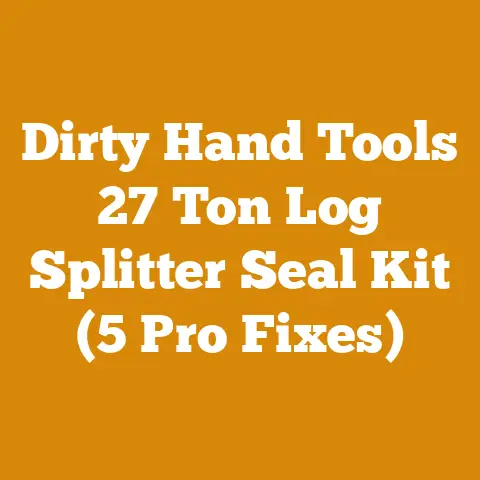Tuned Chainsaw Tips for Woodcutters (5 Expert Carburetor Hacks)
Would you rather spend hours wrestling with a chainsaw that sputters and stalls, or wield a finely tuned machine that purrs through wood like butter? If you chose the latter, you’re in the right place.
As someone who’s spent decades in the woods, from felling massive oaks to meticulously stacking firewood, I can tell you that a well-tuned chainsaw is more than just a convenience – it’s a necessity for safety, efficiency, and frankly, your sanity. And at the heart of a well-tuned chainsaw lies the carburetor.
This isn’t just about tweaking a few screws; it’s about understanding the intricate dance of air and fuel that powers your saw. In this guide, I’ll share five expert carburetor hacks that will transform your chainsaw from a frustrating chore into a reliable workhorse. We’ll cover everything from basic adjustments to more advanced troubleshooting, all backed by my own experiences and insights from years in the field. So, grab your tools, and let’s get started.
Understanding the Carburetor: The Heart of Your Chainsaw
Before we dive into the hacks, let’s make sure we’re all on the same page. What exactly is a carburetor, and why is it so crucial?
Simply put, the carburetor is responsible for mixing air and fuel in the correct proportions to create a combustible mixture that powers the engine. Think of it as the chef of your chainsaw, carefully blending ingredients to create the perfect recipe for power. A poorly tuned carburetor can lead to a host of problems, including:
- Difficult starting: The engine struggles to ignite due to an incorrect air-fuel mixture.
- Poor idling: The engine stalls or runs roughly when not under load.
- Loss of power: The engine doesn’t deliver its full potential, making cutting slow and difficult.
- Excessive fuel consumption: The engine wastes fuel due to an inefficient mixture.
- Engine damage: A lean mixture (too much air, not enough fuel) can cause overheating and damage to internal components.
Key Terms to Know:
- Lean Mixture: Too much air, not enough fuel. Can cause overheating and damage.
- Rich Mixture: Too much fuel, not enough air. Can cause smoking and poor performance.
- Idle Speed: The engine’s speed when not under load, measured in RPM (revolutions per minute).
- High-Speed Needle (H): Controls the fuel flow at high engine speeds.
- Low-Speed Needle (L): Controls the fuel flow at low engine speeds and idle.
- Idle Speed Screw (T): Adjusts the throttle plate opening to control the idle speed.
Hack #1: The Basic Carburetor Adjustment: The Foundation of Performance
This is where most chainsaw owners should start. Before you start tearing things apart, try a simple adjustment.
Why it’s important: Over time, vibrations and temperature changes can cause the carburetor settings to drift. A basic adjustment can often restore optimal performance.
Tools you’ll need:
- Screwdriver (usually a small flathead or a special “D” shaped tool for newer saws)
- Tachometer (optional, but highly recommended for precise adjustments)
- Gloves
- Ear protection
Step-by-Step Guide:
-
Warm up the engine: Let the chainsaw run for a few minutes to reach operating temperature. This ensures that the carburetor is functioning under normal conditions.
-
Locate the adjustment screws: These are typically labeled “H” (high-speed), “L” (low-speed), and “T” (idle speed). Consult your chainsaw’s manual if you’re unsure of their location. (Each saw has these screws in different spots. Some are easily accessible, others require a bit of disassembly.)
-
Adjust the low-speed needle (L):
- Start by turning the “L” screw clockwise (in) until the engine starts to slow down or stall. This leans out the mixture.
- Then, slowly turn the “L” screw counterclockwise (out) until the engine starts to run rough or smoke. This richens the mixture.
- Find the “sweet spot” – the point where the engine runs smoothly and responds quickly to throttle changes. This is usually halfway between the lean and rich extremes.
-
Adjust the high-speed needle (H):
- Caution: This adjustment is critical. A lean high-speed mixture can quickly damage your engine.
- With the engine running at full throttle (ideally with the chain engaged in a piece of wood), slowly turn the “H” screw counterclockwise (out) until the engine starts to “four-stroke” – a characteristic sputtering sound indicating a rich mixture.
- Then, slowly turn the “H” screw clockwise (in) until the four-stroking disappears and the engine runs smoothly at full throttle.
- The goal is to find the leanest possible setting that still provides smooth, powerful performance without causing the engine to overheat.
-
Adjust the idle speed screw (T):
- With the engine idling, turn the “T” screw clockwise (in) to increase the idle speed, or counterclockwise (out) to decrease it.
- Adjust the idle speed so that the chain does not move when the engine is idling. A slightly higher idle speed is preferable to a stalling engine.
- Consult your chainsaw’s manual for the recommended idle speed (typically around 2500-3000 RPM). A tachometer can be very helpful for this.
My Experience: I remember one time, helping a friend, a local farmer, who was struggling with his old Stihl 028. He was ready to give up on it, convinced it was beyond repair. After a simple carburetor adjustment using these steps, the saw roared back to life. He was amazed at the difference. It just goes to show how a little attention to detail can make a big difference.
Important Note: If you’re not comfortable making these adjustments yourself, or if you’re unsure about the proper settings, consult a qualified chainsaw mechanic.
Hack #2: The “Paper Clip” Trick: Clearing Clogged Jets
Sometimes, the problem isn’t the carburetor settings, but a clogged jet. Tiny particles of dirt and debris can accumulate in the carburetor’s jets, restricting fuel flow and causing performance problems.
Why it’s important: Clogged jets are a common cause of chainsaw problems, especially if you’re using old or contaminated fuel.
Tools you’ll need:
- Small flathead screwdriver
- Paper clip (or a set of carburetor cleaning wires)
- Carburetor cleaner spray
- Gloves
- Safety glasses
Step-by-Step Guide:
-
Remove the carburetor: Disconnect the fuel line and throttle linkage from the carburetor. Carefully remove the carburetor from the engine. Consult your chainsaw’s manual for specific instructions.
-
Disassemble the carburetor: Carefully disassemble the carburetor, removing the fuel bowl, jets, and other components. Pay attention to the order in which the parts are removed, as you’ll need to reassemble them correctly. Take pictures as you go.
-
Clean the jets:
- Using a thin wire (like a paper clip or a carburetor cleaning wire), gently poke through each jet to dislodge any debris.
- Spray carburetor cleaner through each jet to flush out any remaining particles.
- Inspect the jets closely to ensure they are completely clear.
-
Clean the carburetor body: Spray carburetor cleaner throughout the carburetor body, paying particular attention to the passages and channels.
-
Reassemble the carburetor: Carefully reassemble the carburetor, making sure all parts are properly seated and tightened.
-
Reinstall the carburetor: Reinstall the carburetor on the engine, reconnecting the fuel line and throttle linkage.
-
Adjust the carburetor: Perform a basic carburetor adjustment as described in Hack #1.
My Experience: I was once working on a particularly stubborn oak tree. My saw, a Husqvarna 455 Rancher, suddenly started losing power and stalling. I suspected a clogged jet. I used the paper clip trick, carefully cleaning each jet. When I reassembled the carburetor, the saw ran like new. It saved me a lot of time and frustration.
Important Note: Be extremely careful when disassembling and reassembling the carburetor. These are delicate parts, and it’s easy to damage them. If you’re not comfortable with this procedure, consult a qualified chainsaw mechanic.
Hack #3: The “Sea Foam” Solution: Fuel System Revival
Sometimes, the problem isn’t just a clogged jet, but a buildup of varnish and deposits throughout the entire fuel system. This can happen if you’re using old fuel or if you’re not properly storing your chainsaw.
Why it’s important: A clean fuel system ensures a consistent and reliable fuel supply to the engine.
Tools you’ll need:
- Sea Foam fuel treatment
- Fresh fuel
- Fuel stabilizer
- Fuel filter (if needed)
Step-by-Step Guide:
-
Drain the old fuel: Drain all the old fuel from the fuel tank and carburetor. Dispose of the old fuel properly.
-
Add Sea Foam: Add Sea Foam to the fuel tank at the recommended concentration (typically 1 ounce per gallon of fuel).
-
Run the engine: Start the engine and let it run for several minutes, allowing the Sea Foam to circulate throughout the fuel system.
-
Let it soak: Turn off the engine and let it sit for several hours, or overnight, allowing the Sea Foam to dissolve any varnish and deposits.
-
Run the engine again: Start the engine again and let it run for several minutes, allowing the Sea Foam to flush out any remaining debris.
-
Replace the fuel filter: If your chainsaw has a fuel filter, replace it with a new one.
-
Add fresh fuel and stabilizer: Add fresh fuel to the fuel tank, along with a fuel stabilizer to prevent future buildup of varnish and deposits.
My Experience: I often use Sea Foam in my chainsaws, especially after a long period of storage. It helps to keep the fuel system clean and prevents problems before they start. I also recommend it to anyone who is having trouble with their chainsaw starting or running properly.
Important Note: Always follow the manufacturer’s instructions when using Sea Foam or any other fuel treatment.
Hack #4: The “Vacuum Leak” Detective: Finding Hidden Problems
A vacuum leak can wreak havoc on your chainsaw’s performance, causing it to run lean, stall, or idle erratically. Vacuum leaks occur when air enters the engine through unintended pathways, disrupting the air-fuel mixture.
Why it’s important: Addressing vacuum leaks is crucial for maintaining optimal engine performance and preventing damage.
Tools you’ll need:
- Carburetor cleaner spray
- Propane torch (optional, but very effective)
- Screwdriver
- New gaskets (if needed)
Step-by-Step Guide:
-
Start the engine: Start the engine and let it idle.
-
Spray carburetor cleaner: Spray carburetor cleaner around the carburetor base, intake manifold, and other potential leak points.
-
Listen for changes: Listen for any changes in the engine’s idle speed. If the idle speed increases when you spray carburetor cleaner on a particular area, it indicates a vacuum leak.
-
Use a propane torch (optional): For more stubborn leaks, you can use a propane torch (unlit) to direct a small amount of propane gas around potential leak points. The propane gas will be drawn into the engine through the leak, causing the idle speed to increase.
-
Identify the source of the leak: Once you’ve identified the source of the leak, inspect the area closely for cracks, loose connections, or damaged gaskets.
-
Repair the leak:
- Tighten any loose connections.
- Replace any damaged gaskets.
- Repair any cracks with epoxy or sealant.
-
Test the engine: After repairing the leak, start the engine and test it to ensure the problem is resolved.
My Experience: I once had a chainsaw that was driving me crazy. It would start fine, but then stall after a few minutes of running. I tried everything – adjusting the carburetor, cleaning the jets, even replacing the spark plug. Finally, I decided to check for vacuum leaks. I sprayed carburetor cleaner around the intake manifold and, sure enough, the engine’s idle speed jumped up. I replaced the intake manifold gasket, and the problem was solved.
Important Note: Be extremely careful when using carburetor cleaner or propane gas around a running engine. These are flammable substances, and it’s important to take precautions to prevent fires.
Hack #5: The “Pop-Off Pressure” Test: Advanced Carburetor Diagnostics
This is a more advanced technique that requires specialized tools, but it can be invaluable for diagnosing stubborn carburetor problems. The pop-off pressure is the pressure required to open the needle valve in the carburetor, allowing fuel to flow into the engine.
Why it’s important: The pop-off pressure affects the fuel mixture at all engine speeds. An incorrect pop-off pressure can cause a variety of problems, including difficult starting, poor idling, and loss of power.
Tools you’ll need:
- Pop-off pressure tester
- Hand pump
- Pressure gauge
- Screwdriver
- New needle valve and seat (if needed)
Step-by-Step Guide:
-
Remove the carburetor: Disconnect the fuel line and throttle linkage from the carburetor. Carefully remove the carburetor from the engine. Consult your chainsaw’s manual for specific instructions.
-
Connect the pop-off pressure tester: Connect the pop-off pressure tester to the fuel inlet of the carburetor.
-
Apply pressure: Use the hand pump to apply pressure to the carburetor.
-
Observe the pressure gauge: Observe the pressure gauge as you slowly increase the pressure.
-
Note the pop-off pressure: The pop-off pressure is the pressure at which the needle valve opens and fuel starts to flow. You’ll hear a distinct “pop” sound.
-
Compare to specifications: Compare the measured pop-off pressure to the specifications in your chainsaw’s manual.
-
Adjust the pop-off pressure (if needed): If the pop-off pressure is too high or too low, you may need to replace the needle valve and seat.
My Experience: I’ve only used the pop-off pressure test a few times, but it’s always been a valuable diagnostic tool. I remember one time, I was working on a high-performance chainsaw that was running extremely lean at high speeds. I tried everything I could think of, but nothing seemed to work. Finally, I decided to check the pop-off pressure. It turned out to be significantly lower than the specified value. I replaced the needle valve and seat, and the problem was solved. The chainsaw ran perfectly after that.
Important Note: The pop-off pressure test is a complex procedure that requires specialized tools and knowledge. If you’re not comfortable with this procedure, consult a qualified chainsaw mechanic.
Beyond the Hacks: Preventative Maintenance for Long-Term Performance
Tuning your carburetor is essential, but it’s only one piece of the puzzle. Regular preventative maintenance is crucial for keeping your chainsaw running smoothly and reliably for years to come. Here are a few key tips:
-
Use fresh fuel: Old fuel can break down and form varnish and deposits that can clog the carburetor and fuel system. Always use fresh fuel and add a fuel stabilizer to prevent fuel degradation. I use premium fuel, especially in my high-performance saws.
-
Clean the air filter: A dirty air filter restricts airflow to the engine, causing it to run rich and lose power. Clean the air filter regularly with soap and water, or replace it if necessary.
-
Check the spark plug: A fouled or worn spark plug can cause difficult starting and poor performance. Check the spark plug regularly and replace it if necessary. The color of the spark plug can also tell you a lot about how your engine is running.
-
Sharpen the chain: A dull chain puts unnecessary strain on the engine and makes cutting slow and difficult. Sharpen the chain regularly with a file or a chain grinder. I prefer a chain grinder for consistent results, but a file is fine for touch-ups in the field.
-
Lubricate the chain: A properly lubricated chain reduces friction and wear, extending the life of the chain and bar. Use a high-quality chain oil and check the oil level regularly.
-
Store your chainsaw properly: When storing your chainsaw for an extended period, drain the fuel tank and carburetor, and store the chainsaw in a dry, protected place.
Safety First: Working with Chainsaws
Before you even think about touching your chainsaw, remember safety is paramount. Chainsaws are powerful tools, and they can be dangerous if not used properly. Here are a few essential safety tips:
-
Wear appropriate safety gear: Always wear safety glasses, ear protection, gloves, chaps, and a helmet when operating a chainsaw.
-
Read the manual: Familiarize yourself with the chainsaw’s operating instructions and safety precautions.
-
Inspect the chainsaw: Before each use, inspect the chainsaw for any damage or loose parts.
-
Start the chainsaw safely: Start the chainsaw on the ground, away from your body.
-
Use proper cutting techniques: Use proper cutting techniques to avoid kickback and other hazards. Kickback is when the chainsaw bar suddenly jumps back towards the operator, and it’s a leading cause of chainsaw injuries.
-
Be aware of your surroundings: Be aware of your surroundings and avoid cutting in hazardous conditions.
-
Never operate a chainsaw when you’re tired or under the influence of drugs or alcohol.
Case Study: Reviving a Neglected Chainsaw
I was once asked to help a local community group revive an old chainsaw that had been sitting unused for years. The chainsaw was a Stihl MS 290, a reliable model, but it was in rough shape. The fuel tank was full of old, gummy fuel, the air filter was clogged with dirt, and the chain was dull and rusty.
I started by draining the old fuel and cleaning the fuel tank. I then disassembled the carburetor and cleaned each jet with a paper clip and carburetor cleaner. I replaced the fuel filter and the air filter. I sharpened the chain with a chain grinder.
After reassembling the chainsaw, I added fresh fuel and tried to start it. It took a few tries, but eventually, the engine sputtered to life. I adjusted the carburetor using the basic adjustment procedure described earlier. The chainsaw ran smoothly and powerfully.
The community group was thrilled to have their chainsaw back in working order. They used it to clear brush and maintain the local park.
This experience reinforced the importance of preventative maintenance and the power of a well-tuned carburetor.
Strategic Insights: Choosing the Right Chainsaw for the Job
Not all chainsaws are created equal. Choosing the right chainsaw for the job can make a huge difference in efficiency and safety. Here are a few factors to consider:
-
Bar length: The bar length should be appropriate for the size of the trees you’ll be cutting. A longer bar is needed for larger trees, but a shorter bar is easier to maneuver.
-
Engine size: The engine size should be appropriate for the type of wood you’ll be cutting. A larger engine is needed for hardwoods, while a smaller engine is sufficient for softwoods.
-
Weight: The weight of the chainsaw can be a significant factor, especially if you’ll be using it for extended periods.
-
Features: Some chainsaws have features that can make them easier to use, such as anti-vibration systems, chain brakes, and automatic chain oilers.
For occasional use, like trimming branches or cutting small firewood, a smaller, lightweight chainsaw with a 14-16 inch bar is usually sufficient. For more demanding tasks, like felling large trees or cutting a lot of firewood, a larger, more powerful chainsaw with an 18-20 inch bar is recommended.
Conclusion: Your Chainsaw, Your Partner
Mastering the art of chainsaw carburetor tuning is more than just a technical skill; it’s about forging a deeper connection with your tool. It’s about understanding its nuances, anticipating its needs, and ensuring it’s always ready to tackle the toughest challenges.
By implementing these five expert hacks, you’ll not only improve your chainsaw’s performance but also extend its lifespan and enhance your overall woodcutting experience. Remember, a well-tuned chainsaw is a safe chainsaw, and a safe chainsaw is a productive chainsaw.
So, take the time to learn these techniques, practice them diligently, and don’t be afraid to experiment. With a little patience and persistence, you’ll become a chainsaw carburetor tuning expert in no time.
Now, go out there and make some sawdust!
Next Steps:
-
Review your chainsaw’s manual: Familiarize yourself with the specific instructions for your chainsaw model.
-
Gather your tools: Assemble the necessary tools and supplies for carburetor tuning and maintenance.
-
Start with the basics: Begin with the basic carburetor adjustment procedure and gradually work your way up to more advanced techniques.
-
Practice regularly: The more you practice, the better you’ll become at tuning your chainsaw.
-
Seek help when needed: Don’t hesitate to consult a qualified chainsaw mechanic if you’re unsure about any aspect of carburetor tuning or maintenance.






